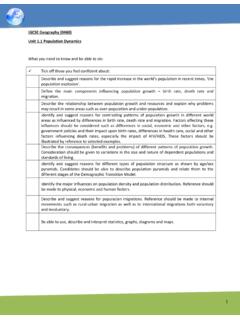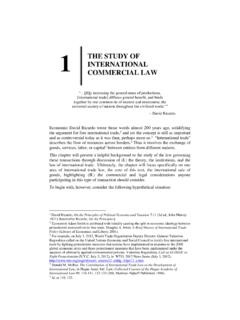Transcription of IGCSE Geography (0460) Unit 1.2 Settlement
1 1 IGCSE Geography (0460) Unit Settlement What you need to know and be able to do: Tick off those you feel confident about: Describe the patterns of rural settlements dispersed, linear, nucleated. Explain how physical factors (relief, soil, water supply) and other factors such as accessibility, agricultural land-use, influence the sites and patterns of rural settlements. Describe and explain the factors which may influence the size, growth and functions of rural and urban settlements. Describe and suggest reasons for the hierarchy of settlements and services. Describe and explain the land-use zones of towns and cities to include the Central Business District (CBD), residential areas, industrial areas, the provision of open spaces and transport routes. Differences in the patterns of urban structures in cities of LEDCs and MEDCs should be identified. Describe problems associated with the growth of urban areas such as congestion in the CBD, housing shortages, traffic congestion, squatter settlements.
2 Suggested solutions to overcome these problems should be illustrated by reference to selected examples. Describe the effects of urbanisation on the environment pollution (air, water, visual and noise), the results of urban sprawl on surrounding areas, the growth of out-of-town urban activities shopping areas, sports facilities, etc. 2 What is a Settlement ? A Settlement is a place where people live. A Settlement may be as small as a single house in a remote area or as a large as a mega city (a city with over 10 million residents). A Settlement may be permanent or temporary. However, a temporary Settlement may become permanent over time. This has happened to many refugee camps that have been built in conflict zones or similarly favelas/shanty towns. The reason a Settlement was developed or built can be thought of as its function. This varies depending on the location of the Settlement . Coastal towns tend to have the original function of being a port for trade, whilst other settlements can have religious, cultural or administrative functions.
3 Settlement site and situation The piece of land upon which a Settlement is built is the Settlement site. There are many reasons why a site might be chosen for the development of a Settlement and some factors will be more important than others. How many features can you spot in the map of Southampton below? Some common site factors include: Wet point sites these have good water supply. Many settlements grew around wet point sites, Vicenza. Dry point sites these are away from the risk of flooding, Bergamo. Defensive sites often found on higher ground so that enemies could be seen from a distance, Monselice. Aspect settlements are often found on the sunny side of a deep valley. This is common in settlements in the Alps. Shelter from cold prevailing winds and rain. Resources important for industry, villages such as Garraf, Barcelona are built to exploit a local resource. Bridging point settlements with 'ford' in their name often grew around a fording point or bridging point, Bassano Del Grappa is built on the River Brenta.
4 trading centres often settlements grow where natural route ways and rivers meet, which helps the development of roads, railways and canals. Padua, Bologna, Florence.. 3 The importance of many of these functions diminish as technological advances enable people to overcome difficulties. Improved transport links, river management and trading partners all influence the function and location of settlements. The situation of a Settlement is its position in relation to the surrounding human and physical features, many of which will have an impact on the Settlement 's type, size and function. With modern settlements remember that decisions about location and situation have been made by planners, but that their priorities may differ from those that determined the location of a historical Settlement like Cittadella. For example, a modern Settlement does not need to be close to a river because drinking water is now piped to our homes and waterways are no longer important for transport.
5 Settlement functions Most large settlements in MEDCs are multifunctional and perform a range of functions such as retail, education and industry. When settlements first started to grow, most had only one distinct function, and others developed as the Settlement grew. Examples of functions: Port the original function of cities such as Liverpool and Southampton. Both are still ports, but this function has diminished in importance and they are now multifunctional. Market town Watford was originally a market town, and although it still holds a regular market, it is now a thriving multifunctional centre. Resort Southport was a popular Victorian seaside resort, although it now has many functions and is a commuter Settlement for Liverpool. Natural resources in the area enabled Sheffield to develop as an important centre in the iron and steel industry. Although steel is still produced, its prominence has declined and Sheffield is a thriving multifunctional city.
6 4 Settlement hierarchies If we group and classify a number of settlements according to their size and shape the result is Settlement hierarchy Pyramid showing relationship between population and services As you move up the hierarchy, the size of the Settlement and the distance between similar sized settlements increases. As you can see from the diagram below, there are more cities than conurbations, more towns than cities and more villages than towns. The number of services that a Settlement provides increases with Settlement size. Small settlements will only provide low order services such as a post offices, doctors and newsagents. Large towns, cities and conurbations will provide low and high order services such as leisure centres, chain stores and hospitals. Larger settlements and conurbations have a much larger sphere of influence than smaller ones. This means they attract people from a wider area because of the facilities they offer. Cities such as London have a global sphere of influence, whereas a small hamlet or village may only have a sphere of influence of a couple of kilometres.
7 The range of a service or product is the maximum distance people are prepared to travel to purchase it. The range of a newspaper is much lower than an item of furniture for example. 5 Land use in MEDC s The Burgess and Hoyt model The Burgess Model (Concentric Ring Model) is based on the idea that land values are highest in the centre of a town or city. This is because competition is high in the central parts of the Settlement . This leads to high-rise, high-density buildings being found near the Central Business District, with low-density, sparse developments on the edge of the town or city The Hoyt model Central business district The land in urban areas is used for many different purposes: Leisure and recreation may include open land, parks or built facilities such as sports centres Residential - the building of houses and flats. Transport - road and rail networks, stations and airports. Business and commerce - the building of offices, shops and banks.
8 Industry - factories, warehouses and small production centres. The Central Business District (CBD) in the city centre is where most business and commerce is located. 6 The following features easily identify the CBD: High/multi-storey buildings. Expensive land values. Department stores or specialist shops, like jewellers. Shopping malls and pedestrian precincts. Cultural/historical buildings, museums and castles. Offices, finance, banks, administration, town hall (business sector). Bus and railway stations (transport centres). Multi-storey car parks. The CBD is located in the centre because it is: A central location for road/railways to converge. The most accessible location for workers. Accessible to most people for shops and businesses. To help you remember how to identify a CBD, think of a city you know. In your exam give named examples for the features listed above. 7 The inner city Terraced houses The inner city is also known as the 'twilight zone'.
9 It is typically found next to the CBD and has mainly terraced houses in a grid like pattern. These were originally built to house factory workers who worked in the inner city factories. Many of these factories have now closed down. Unemployment and other socio-economic problems have led to periods of unrest in many inner city areas. Many inner city areas declined in the late 20th century and have undergone a period of regeneration in recent years. Run down terraced housing is often bought by investors and improved to appeal to young professionals who need access to the CBD. This is called gentrification. The suburbs Semi-detached Suburban houses are usually larger than inner city terraces and most have a garden. Typically, they are detached or semi detached and the roads around them are arranged in cul-de-sacs and wide avenues. Land prices are generally cheaper than in the CBD and inner city, although the desirability of housing can make some areas expensive.
10 Facilities such as schools, places of worship and parks are often present, and many are served by a local supermarket. Suburban areas are often home to commuters who need access to the CBD along main roads and railways, and they are also within easy reach of the countryside. 8 The urban rural fringe Allotments in Ripon, North Yorkshire This is found at the edge of a town or city and is where town meets country. It is common for this area to have a mixture of land uses such as some housing, golf courses, allotments, business parks and airports. The mixture of land use often causes conflict as different groups have different need and interests. For example, building Terminal 5 at Heathrow on the outskirts of London was a source of controversy. The need for another runway continues to cause conflicts of interest. Land use in LEDC s LEDCs have similar land-use needs to MEDCs, but the pattern of land use in urban areas is different.





